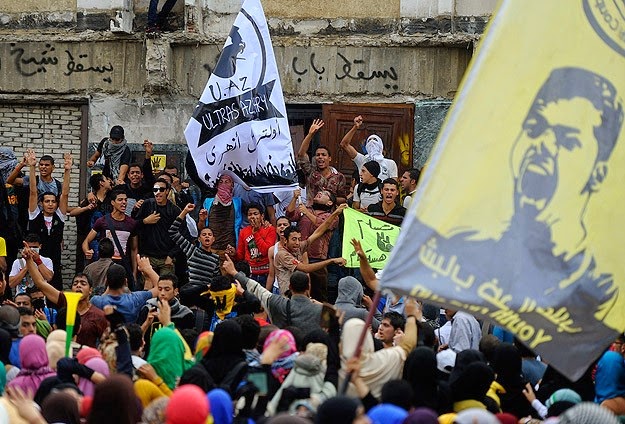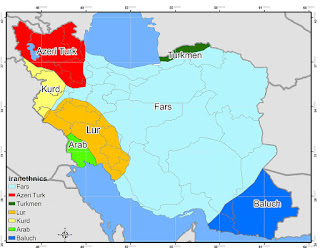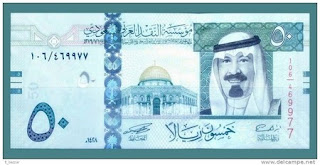Egyptian campuses and soccer emerge as flashpoint in resistance to President Al Sisi
By James M. Dorsey
Soccer fans exploiting stadia as contested public space
emerged more than three years ago as a key force in anti-government protests
that toppled Egyptian President Hosni Mubarak and opposition to subsequent
military rule. With stadia closed to spectators for much of the period since
then, protesting students backed by militant football fans have turned
university campuses into the new stadia with hundreds detained and scores
killed. Theirs is a battle for public space and resistance to efforts by
general-turned-president Abdel Fattah Al Sisi to depoliticize youth emboldened
by its success in overthrowing a dictator after 30 years in office and angered
by their being side-lined in the wake of their successful revolt and the
rolling back of heavily fought achievements.
With Mr. Al Sisi employing brute force by security forces, a
private security firm reportedly owned by generals and regime-friendly
businessmen, and Mubarak-era thugs, and a crackdown on academic freedom to
impose his will, flashpoints loom beyond campuses on the horizon. These
potential flashpoints include a pending court case that could lead to the
banning as a terrorist organization of the Ultras White Knights (UWK), the
militant support group of storied Al Zamalek SC that played a crucial role in
the uprising against Mubarak; the appeal against the sentencing to death of 21
people and lengthy prison sentence for others on charges that they were
responsible for a 2012 politically loaded brawl in Port Said in which 74 Al
Ahli SC fans died that is certain to spark protest once a verdict is announced;
and the continued ban on spectators attending professional soccer matches.
The student protests have served to forge links between
supporters of the outlawed Muslim Brotherhood whose Mohammed Morsi, Egypt’s
first and only democratically elected president, Mr. Al Sisi overthrew in a
military coup last year, and secular youth groups that constituted the backbone
of the 2011 popular uprising. The influence of Ultras Nahdawy, a group was
formed by militant pro-Brotherhood supporters of Zamalek and its arch rival, Al
Ahli, is visible in video clips of the protests in which protesters much like
militant soccer fans jump up and down while chanting and fire off coloured
flares and smoke bombs.
Human Rights groups have alleged excessive use of force in
crackdowns on the protesters who demand the release of some 100 detained
students, the reinstatement of at least 170 others expelled from universities,
and the restoration of academic freedom. ““The Egyptian security forces have a
bleak record of using arbitrary and abusive force against protesters including
students. The lack of accountability for such violations, including unlawful killings,
gives them the green light to carry on brutalizing protesters,” said Amnesty
International Deputy Director for the Middle East and North Africa Hassiba Hadj
Sahraoui.
Against the backdrop of last year’s bloody crackdown on the
Brotherhood, the arrest of tens of thousands of Islamist and secular regime
critics, and the adoption of a draconic anti-protest law, Mr. Al Sisi has
sought to impose his will on universities by decreeing that the heads of
universities should be government-appointed rather than elected; authorizing
the dismissal of faculty with no right of appeal, and inserting a pledge to
refrain from political activity in students’ housing contracts. The government’s
concern about the role of soccer fans in protest was highlighted in recent days
by a decision to move an Al Ahli match from Beni Suef, a town 115 kilometres south
of Cairo, to Assiut that lies 200 kilometres further south of the Egyptian
capital.
Lack of public space under Mr. Mubarak who tolerated no
uncontrolled public space propelled highly politicized, well-organized, street
battle-hardened soccer fans to the forefront of anti-government protest.
History threatens to repeat itself under Mr. Al Sisi even if the president
acknowledges that the government has failed to reach out to youth under the age
of 25 who account for half of the Egyptian population. That gap was fuelled by
the side lining of the youth almost from the day that Mr. Mubarak was forced to
resign. It was further evident with relatively few youth participating in a
referendum under post-Morsi military-backed rule and in Mr. Al Sisi’s election.
The low youth participation stood in stark contrast to the large numbers that
participated in parliamentary elections in 2012 and the polls that brought Mr.
Morsi to power.
Mr. Al Sisi has promised to correct the situation by
creating a National Youth Council, increasing opportunities for youth
participation in politics, and enhancing scholarship openings for study
overseas. At the same time, the president warned students and youth from
engaging in activity “with questionable political goals that serve the
interests of unpatriotic groups in their endeavour to destroy the nation.” Mr.
Al Sisi’s warning appears to have so far fallen on deaf ears with a large
number of students, fans and youths evidently putting little faith in his
promises.
“The student movement
is and always will be an indication of the state of the country. Today in
Egypt, as long as the students are active and protesting then the revolution is
ongoing… The killing or arrest of those who oppose the regime with the
intention of restricting or stifling political dissent will not silence nor
destroy the idea and the resolve of what thousands have given their lives for
since January 25, 2011, that of freedom, democracy, justice and an honourable
dignified life,” wrote Oxford University scientist Walaa Ramadan on Middle East
Monitor.
Ms. Ramadan warned that Mr. Al Sisi was facing “a generation
which is adamant to fulfil its dreams and hold on to its liberty, a generation
which toppled a historic dictator within days and has since resolved to give
their lives to achieve the freedoms they fought for…”
James M.
Dorsey is a senior fellow at the S. Rajaratnam School of International Studies
as Nanyang Technological University in Singapore, co-director of the Institute
of Fan Culture of the University of Würzburg and the author of the blog, The Turbulent World of Middle East Soccer, and a forthcoming book with the
same title.





Comments
Post a Comment